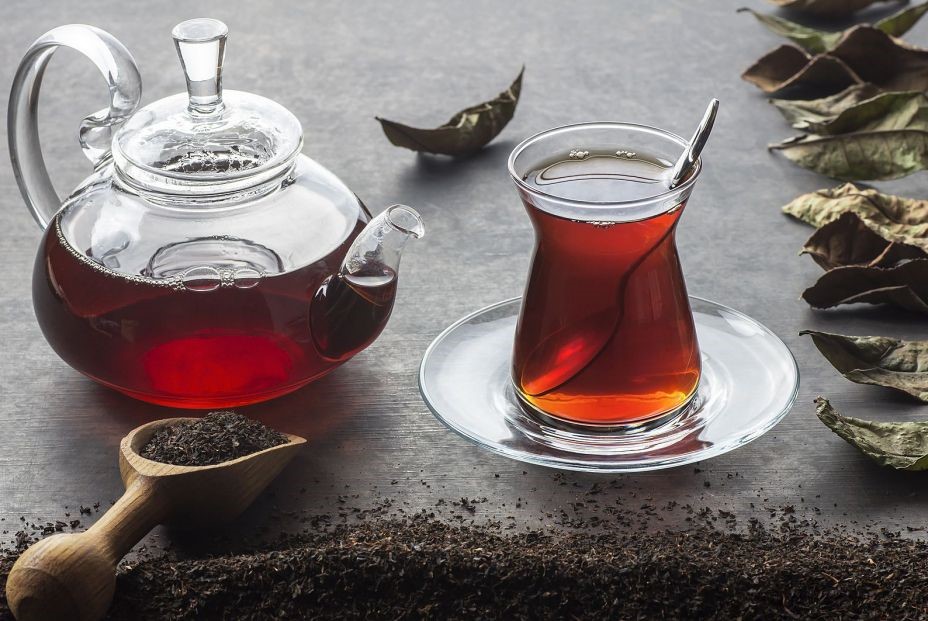El té negro se elabora a partir de las hojas fermentadas de la planta Camellia sinensis y tiene un grado de oxidación del 100%. Esto se debe a que durante el proceso de elaboración se rompen las células de las hojas, provocando una reacción química con el oxígeno del aire que oscurece el té dando como resultado un color negruzco o amarronado en las hebras.
Se caracteriza por tener un licor más intenso que el de un té blanco o té verde; en él podemos percibir notas ahumadas, a madera, tabaco y cacao; en otras, abundan las notas florales, de frutas rojas y de frutas pasas.

PROPIEDADES
- El té negro contiene del 2% al 4% de cafeína, mejora el estado de alerta.
- Activa la mente, permite mejorar la concentración y favorece a la memoria.
- Se usa tanto para la presión arterial alta como para la baja.
- Ayuda a mantener sanas las arterias pudiendo prevenir enfermedades cardiacas.
- Previene la enfermedad de Parkinson, la depresión, la demencia y los accidentes cerebrovasculares.
- Es ideal para consumirse antes de las comidas, ya que prepara el aparato digestivo para trabajar correctamente.
- Por su contenido de Flúor ayuda a prevenir caries y enfermedades bucales.
- Fortalece los huesos por la gran cantidad de fitoquímicos.
- Permite reducir los niveles de azúcar en sangre.
- Contribuye a reducir el colesterol.
- Colabora a reducir el estrés.
- Protege el sistema inmunitario y ayuda a combatir infecciones.
- Sus altas cantidades de antioxidantes evitan el daño de los tejidos y mantienen a las células saludables por más tiempo, logrando retrasar el envejecimiento.
- Acelera el metabolismo, favorece la pérdida de peso y moldea la cintura.

COMPRA EN LÍNEA:
https://hierbasdemexico.com.mx/tienda/
Siempre es bueno estar informado al 100% y consultar con tu médico de confianza antes de tomar cualquier suplemento.
Producto 100% natural, su uso está destinado al consumo como alimento.
EL CONSUMO DE ESTE PRODUCTO ES RESPONSABILIDAD DE QUIEN LO RECOMIENDA Y DE QUIEN LO USA
REFERENCIAS
Wei C, Yang H, Wang S, Zhao J, Liu C, Gao L, Xia E, Lu Y, Tai Y, She G, Sun J, Cao H, Tong W, Gao Q, Li Y, Deng W, Jiang X, Wang W, Chen Q, Zhang S, Li H, Wu J, Wang P, Li P, Shi C, Zheng F, Jian J, Huang B, Shan D, Shi M, Fang C, Yue Y, Li F, Li D, Wei S, Han B, Jiang C, Yin Y, Xia T, Zhang Z, Bennetzen JL, Zhao S, Wan X.Proc Natl Acad Sci U S A. 2018 May 1;115(18):E4151-E4158. doi: 10.1073/pnas.1719622115. Epub 2018 Apr 20.PMID: 29678829 Free PMC article.
Here we present a high-quality sequence of the genome of tea, Camellia sinensis var. sinensis (CSS), using both Illumina and PacBio sequencing technologies. At least 64% of the 3.1-Gb genome assembly consists of repetitive sequences, and the rest yields 33,93 …
2) Safety Assessment of Camellia sinensis-Derived Ingredients As Used in Cosmetics.
Becker LC, Bergfeld WF, Belsito DV, Hill RA, Klaassen CD, Liebler DC, Marks JG Jr, Shank RC, Slaga TJ, Snyder PW, Gill LJ, Heldreth B.Int J Toxicol. 2019 Nov/Dec;38(3_suppl):48S-70S. doi: 10.1177/1091581819889914.PMID: 31840549 Review.
Cosmetic ingredients derived from Camellia sinensis (tea) plant parts function as antioxidants and skin conditioning agents-humectant and miscellaneous. …Because product formulations may contain multiple botanical ingredients, each containing the same constituents …
Bag S, Mondal A, Banik A.Microbiol Res. 2022 Jan;254:126890. doi: 10.1016/j.micres.2021.126890. Epub 2021 Oct 9.PMID: 34689100 Review.
Tea (Camellia sinensis) is perhaps the most popular and economic beverage in the globe due to its distinctive fragrance and flavour generated by the leaves of commercially farmed tea plants. …
Xie H, Feng X, Wang M, Wang Y, Kumar Awasthi M, Xu P.Bioengineered. 2020 Dec;11(1):1001-1015. doi: 10.1080/21655979.2020.1816788.PMID: 32881650 Free PMC article. Review.
We explore the recent studies regarding isolation approaches, distribution characteristics and diversity, and also biological functions of endophytic microbiota in Camellia sinensis (L.) O. Kuntze. Profoundly, the future insight into interaction mechanism between en …
Sun Y, Zhou J, Guo J.Front Biosci (Landmark Ed). 2021 Dec 30;26(12):1714-1722. doi: 10.52586/5063.PMID: 34994184 Free article. Review.
Abiotic stresses are wide-ranging environmental factors that adversely affect the yield and quality of tea plants (Camellia sinensis). As perennial woody economic plants, various environmental factors affect its growth and development. …



